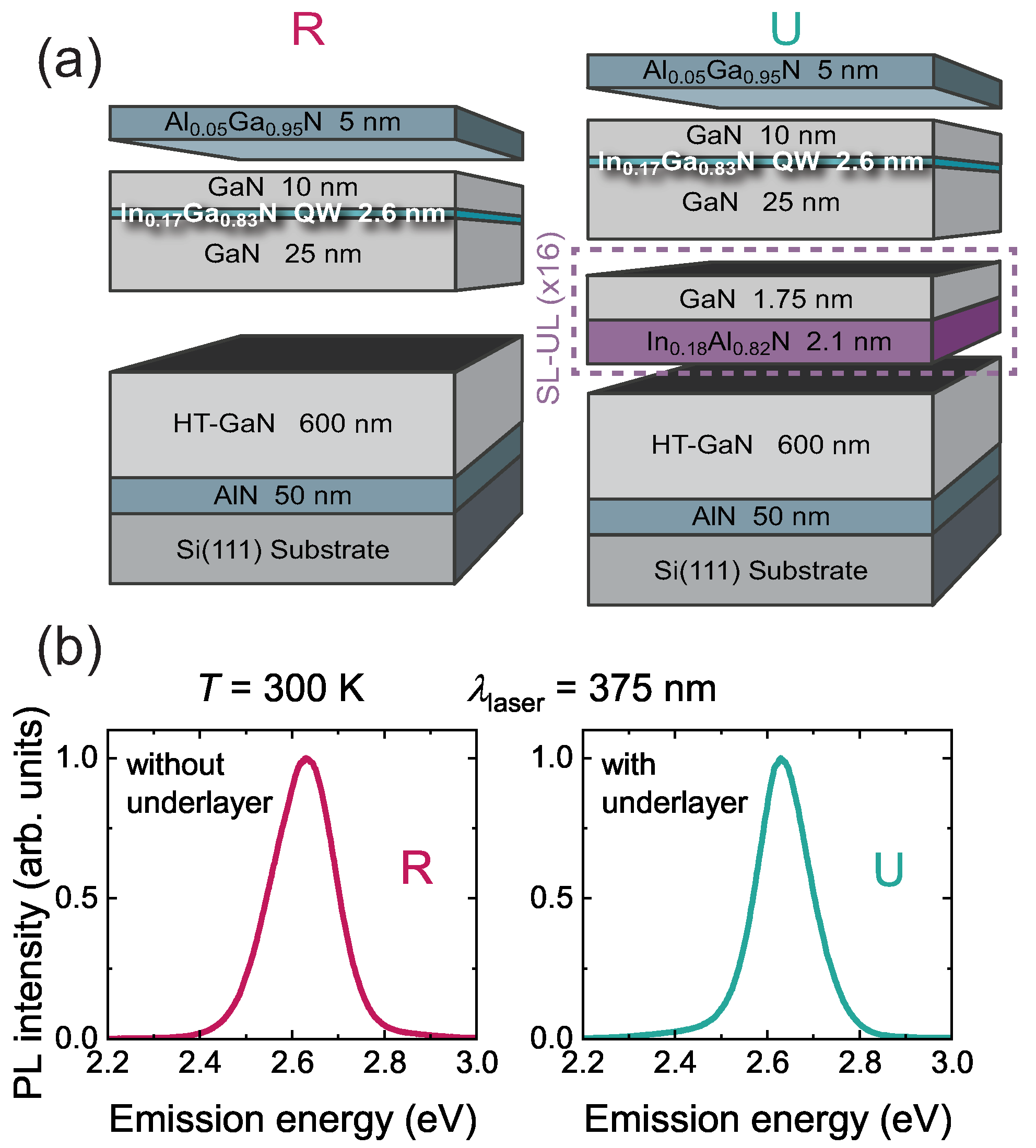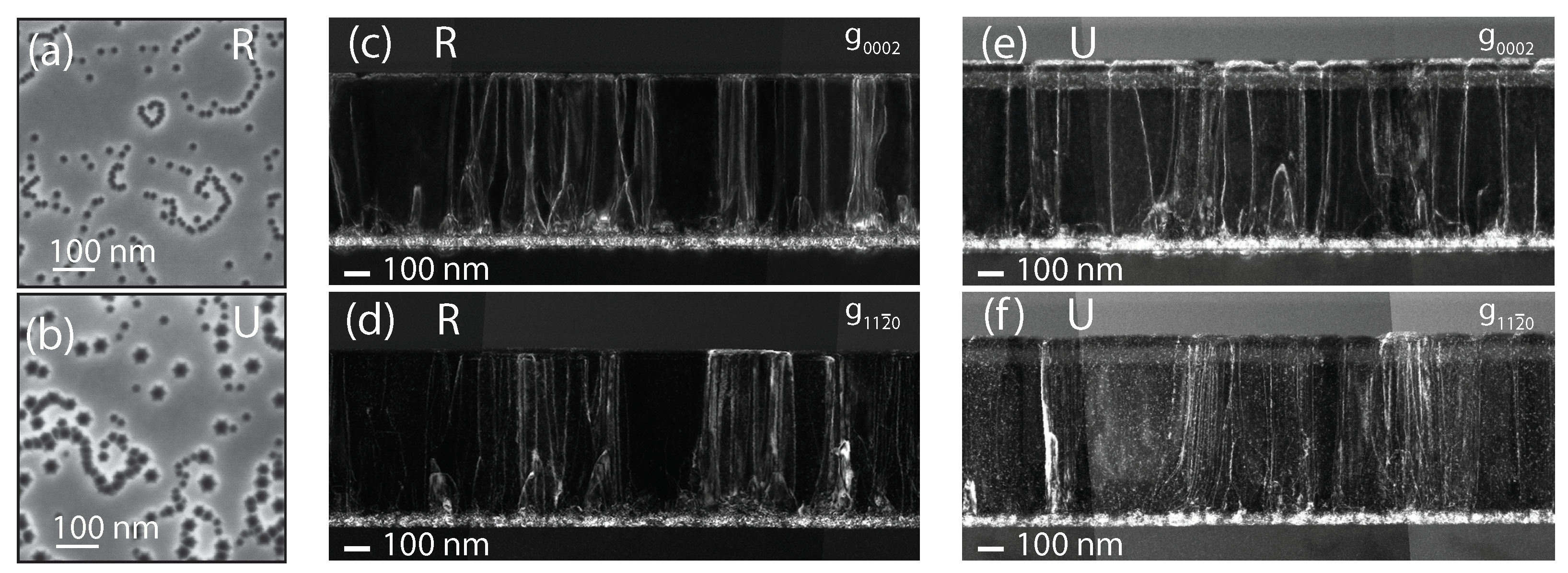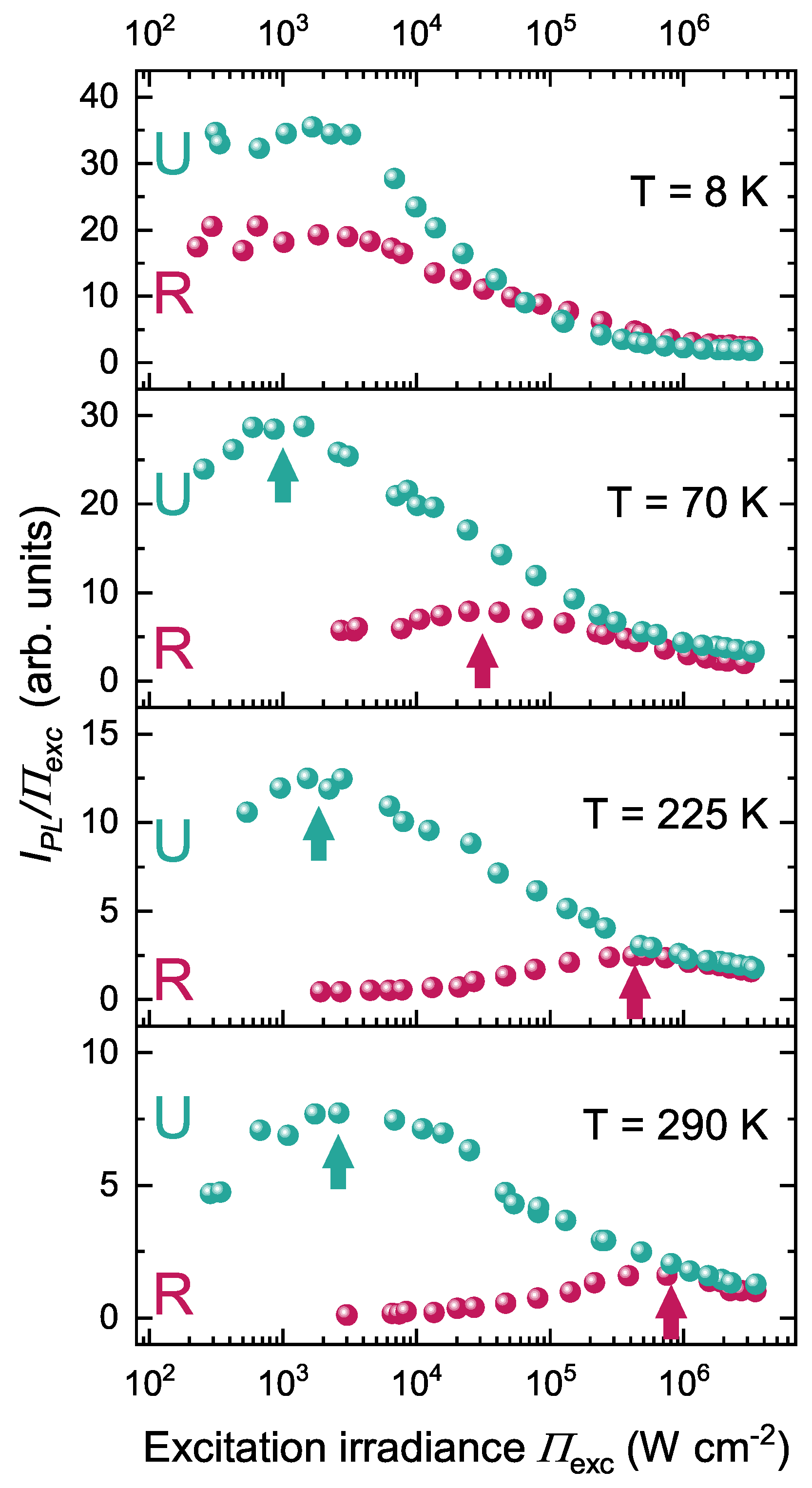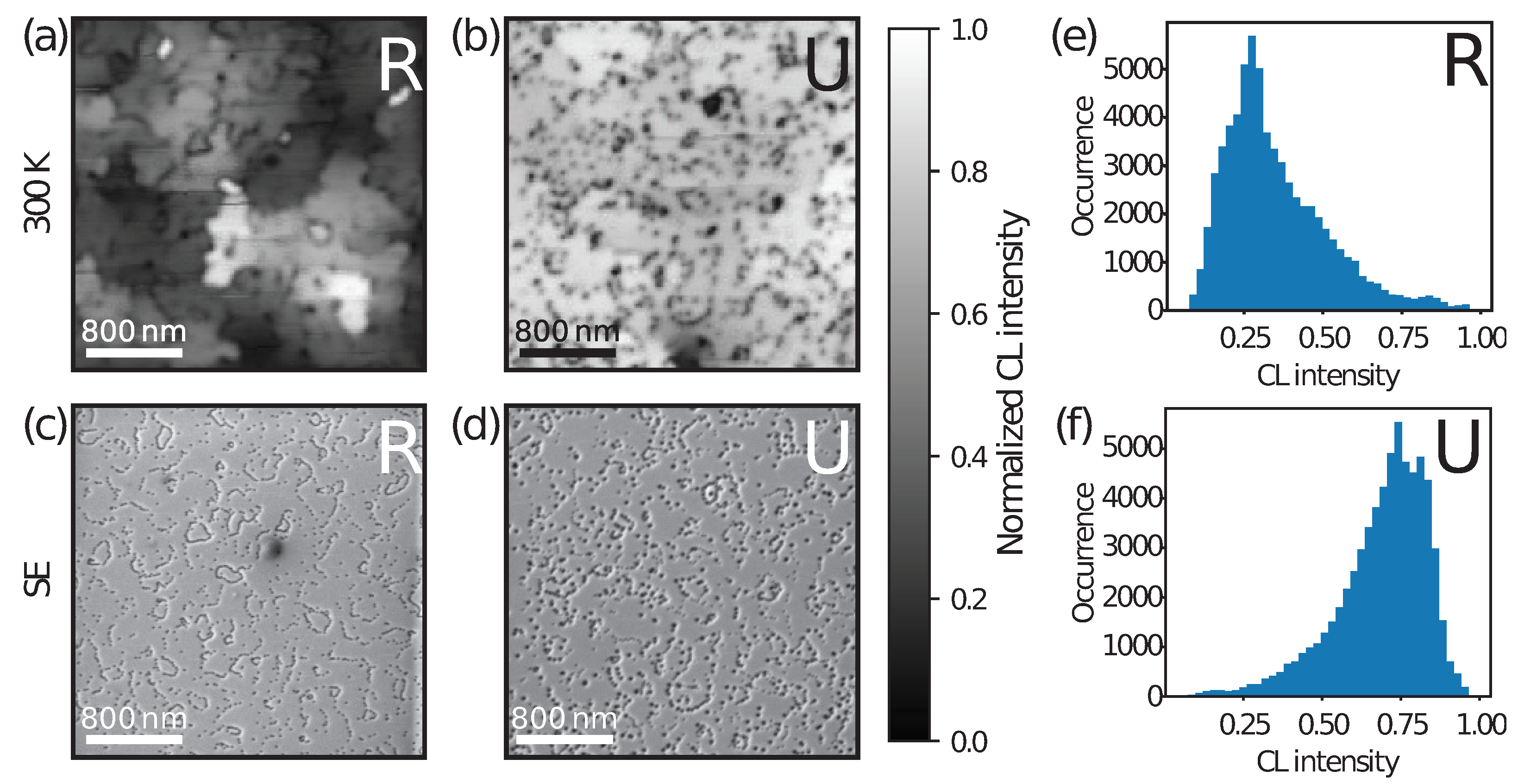Investigation of the Impact of Point Defects in InGaN/GaN Quantum Wells with High Dislocation Densities
Abstract
:1. Introduction
2. Materials and Methods
3. Results and Discussion
3.1. Morphological Study
3.2. Optical Measurements
3.3. Cathodoluminescence Measurements
4. Conclusions
Supplementary Materials
Author Contributions
Funding
Data Availability Statement
Acknowledgments
Conflicts of Interest
Abbreviations
| QW | quantum well |
| TD | threading dislocation |
| LED | light-emitting diode |
| III-N | III-nitride |
| NRC | nonradiative recombination center |
| TRPL | time-resolved photoluminescence |
| CL | cathodoluminescence |
| HT | high temperature |
| SEM | scanning electron microscopy |
| TEM | transmission electron microscopy |
| IQE | internal quantum efficiency |
| MOVPE | metal–organic vapor-phase epitaxy |
References
- Nakamura, S.; Mukai, T.; Senoh, M. Candela-class high-brightness InGaN/AlGaN double-heterostructure blue-light-emitting diodes. Appl. Phys. Lett. 1994, 64, 1687–1689. [Google Scholar] [CrossRef]
- Nakamura, S.; Senoh, M.; Iwasa, N.; Nagahama, S.; Yamada, T.; Mukai, T. Superbright Green InGaN Single-Quantum-Well-Structure Light Emitting Diodes. Jpn. J. Appl. Phys. 1995, 34, L1332–L1335. [Google Scholar] [CrossRef]
- Lester, S.D.; Ponce, F.A.; Craford, M.G.; Steigerwald, D. High dislocation densities in high-efficiency GaN-based light-emitting diodes. Appl. Phys. Lett. 1995, 66, 1249–1251. [Google Scholar] [CrossRef]
- Ponce, F.A.; Bour, D.P. Nitride-based semiconductors for blue and green light-emitting devices. Nature 1997, 386, 351–359. [Google Scholar] [CrossRef]
- Herzog, A.H.; Keune, D.L.; Craford, M.G. The electrical and optical properties of GaAs. J. Appl. Phys. 1972, 43, 600–608. [Google Scholar] [CrossRef]
- Roedel, R.J.; Von Neida, A.R.; Caruso, R.; Dawson, L.R. The Effect of Dislocations in Ga1-xAlxAs. J. Electrochem. Soc. 1979, 126, 637–641. [Google Scholar] [CrossRef]
- Nakamura, S.; Pearton, S.; Fasol, G. The Blue Laser Diode: The Complete Story, 2nd ed.; Springer: Berlin/Heidelberg, Germany, 2000. [Google Scholar]
- Chichibu, S.; Azuhata, T.; Sota, T.; Nakamura, S. Spontaneous emission and recombination dynamics of excess carriers in InGaN single quantum wells. Appl. Phys. Lett. 1996, 69, 4188–4190. [Google Scholar] [CrossRef]
- Chichibu, S.F.; Uedono, A.; Onuma, T.; Haskell, B.A.; Chakraborty, A.; Koyama, T.; Fini, P.T.; Keller, S.; DenBaars, S.P.; Speck, J.S.; et al. Origin of defect-insensitive emission probability and piezoelectric field strength in In-containing (Al, In, Ga) N alloy semiconductors. Nat. Mater. 2006, 5, 810–816. [Google Scholar] [CrossRef]
- Filoche, M.; Piccardo, M.; Wu, Y.R.; Li, C.K.; Weisbuch, C.; Mayboroda, S. Localization and funneling of resonant states. Phys. Rev. B 2017, 95, 144204. [Google Scholar] [CrossRef]
- Hangleiter, A.; Hitzel, F.; Netzel, C.; Fuhrmann, D.; Rossow, U.; Ade, G.; Hinze, P. Suppression of nonradiative recombination by V-shaped pits in GaN. Phys. Rev. Lett. 2005, 95, 127402. [Google Scholar] [CrossRef]
- Armstrong, A.M.; Crawford, M.H.; Koleske, D.D.; Lee, S.R.; Wierer, J.J. Contribution of deep-level defects to decreasing radiative efficiency in InGaN/GaN light-emitting diodes with increasing temperature. J. Appl. Phys. 2015, 117, 134501. [Google Scholar] [CrossRef]
- Haller, C.; Carlin, J.F.; Jacopin, G.; Liu, W.; Martin, D.; Butté, R.; Grandjean, N. GaN surface as the source of non-radiative defects in InGaN/GaN quantum wells. Appl. Phys. Lett. 2018, 113, 111106. [Google Scholar] [CrossRef]
- Chen, Y.; Liu, W.; Haller, C.; Karpov, S.Y.; Carlin, J.F.; Grandjean, N. Impact of InGaN underlayer on the density of nonradiative defects in InGaN/GaN multiple quantum wells. Appl. Phys. Lett. 2021, 118, 111102. [Google Scholar] [CrossRef]
- Piva, F.; De Santi, C.; Caria, A.; Haller, C.; Carlin, J.F.; Mosca, M.; Meneghesso, G.; Zanoni, E.; Grandjean, N.; Meneghini, M. Defect incorporation in In-containing layers and quantum wells. J. Phys. D Appl. Phys. 2021, 54, 025108. [Google Scholar] [CrossRef]
- Armstrong, A.M.; Bryant, B.N.; Crawford, M.H.; Koleske, D.D.; Lee, S.R.; Wierer, J.J. Defect reduction in InGaN/GaN multiple quantum well light emitting diodes. J. Appl. Phys. 2015, 117, 134501. [Google Scholar] [CrossRef]
- Haller, C.; Carlin, J.F.; Mosca, M.; Rossell, M.D.; Erni, R.; Grandjean, N. InAlN underlayer for near ultraviolet InGaN-based light emitting diodes. Appl. Phys. Express 2019, 12, 034002. [Google Scholar] [CrossRef]
- Weatherley, T.F.K.; Liu, W.; Osokin, V.; Alexander, D.T.L.; Taylor, R.A.; Carlin, J.F.; Butté, R.; Grandjean, N. Imaging nonradiative point defects in InGaN/GaN quantum wells. Nano Lett. 2021, 21, 5217–5224. [Google Scholar] [CrossRef]
- Wu, X.H.; Elsass, C.R.; Abare, A.; Mack, M.; Keller, S.; Petroff, P.M.; DenBaars, S.P.; Speck, J.S. Dislocation density reduction via lateral epitaxial overgrowth of GaN on SiC substrates. Appl. Phys. Lett. 1998, 72, 692–694. [Google Scholar] [CrossRef]
- Wu, X.H.; Fini, P.; Tarsa, E.J.; Heying, B.; Keller, S.; Mishra, U.K.; DenBaars, S.P.; Speck, J.S. Dislocation density reduction in GaN films via low pressure metalorganic chemical vapor deposition and its effect on the photoluminescence and electrical characteristics of GaN p–n junction diodes. J. Cryst. Growth 1998, 189–190, 231–243. [Google Scholar] [CrossRef]
- Oveisi, E.; Spadaro, M.C.; Rotunno, E.; Grillo, V.; Hébert, C. Insights into the imaging of dislocations in ADF-STEM. Ultramicroscopy 2019, 200, 139–148. [Google Scholar] [CrossRef]
- Chen, Y.; Takeuchi, T.; Amano, H.; Akasaki, I.; Yamada, N.; Kaneko, Y.; Wang, S.Y. Self-induced growth of strain-relaxed InGaN layers leading to room-temperature multiple-quantum-well laser diodes. Appl. Phys. Lett. 1998, 72, 710–712. [Google Scholar] [CrossRef]
- Zhou, S.; Liu, X.; Yan, H.; Gao, Y.; Xu, H.; Zhao, J.; Quan, Z.; Gui, C.; Liu, S. Cathodoluminescence imaging and spectroscopy for low threading dislocation density GaN grown by metal organic chemical vapor deposition. Sci. Rep. 2018, 8, 11053. [Google Scholar] [CrossRef] [PubMed]
- David, A.; Young, N.G.; Lund, C.; Craven, M.D. Review—Physics of nitride light-emitting diodes: Impact of dislocations and polarization. ECS J. Solid State Sci. Technol. 2020, 9, 016021. [Google Scholar] [CrossRef]
- Solowan, H.M.; Danhof, J.; Schwarz, U.T. The influence of extended defects on the electrical properties of InGaN/GaN multiple quantum well light emitting diodes. Jpn. J. Appl. Phys. 2013, 52, 08JK07. [Google Scholar] [CrossRef]
- David, A. Long-range order of threading dislocation densities in InGaN/GaN multiple quantum wells. Phys. Rev. Appl. 2021, 15, 054015. [Google Scholar] [CrossRef]
- Becht, C.; Schwarz, U.T.; Binder, M.; Galler, B. Diffusion of hydrogen in GaN and its impact on dislocation density. Phys. Status Solidi 2023, 240, 2200565. [Google Scholar] [CrossRef]
- Watanabe, K.; Yang, J.R.; Huang, S.Y.; Inoke, K.; Hsu, J.T.; Tu, R.C.; Yamazaki, T.; Nakanishi, N.; Shiojiri, M. Formation of a dislocation-free InGaN layer with minimized wavelength shift by selective area growth. Appl. Phys. Lett. 2003, 82, 718–720. [Google Scholar] [CrossRef]
- Netzel, C.; Bremers, H.; Hoffmann, L.; Fuhrmann, D.; Rossow, U.; Hangleiter, A. Emission properties of dislocations in InGaN. Phys. Rev. B 2007, 76, 155322. [Google Scholar] [CrossRef]
- Sharma, N.; Thomas, P.; Tricker, D.; Humphreys, C. Chemical contrast of threading dislocations in GaN. Appl. Phys. Lett. 2000, 77, 1274–1276. [Google Scholar] [CrossRef]
- Sarzyński, M.; Suski, T.; Staszczak, G.; Khachapuridze, A.; Domagała, J.Z.; Czernecki, R.; Plesiewicz, J.; Pawłowska, J.; Najda, S.P.; Boćkowski, M.; et al. Lateral distribution of nonradiative recombination centers in dislocation-free GaN homoepitaxy. Appl. Phys. Express 2012, 5, 021001. [Google Scholar] [CrossRef]
- Oliver, R.A.; Massabuau, F.C.-P.; Kappers, M.J.; Phillips, W.A.; Thrush, E.J.; Tartan, C.C.; Blenkhorn, W.E.; Badcock, T.J.; Dawson, P.; Hopkins, M.A.; et al. Impact of threading dislocations on the efficiency of GaN-based light emitting diodes. Appl. Phys. Lett. 2013, 103, 141114. [Google Scholar] [CrossRef]
- Wallace, M.J.; Edwards, P.R.; Kappers, M.J.; Hopkins, M.A.; Oehler, F.; Sivaraya, S.; Allsopp, D.W.E.; Oliver, R.A.; Humphreys, C.J.; Martin, R.W. Bias enhanced nucleation of GaN nanowires: The role of threading dislocations. J. Appl. Phys. 2014, 116, 033105. [Google Scholar] [CrossRef]
- Ding, B.; Jarman, J.; Kappers, M.J.; Oliver, R.A. Combined electron beam and thermal annealing of InGaN. J. Phys. D Appl. Phys. 2021, 54, 165107. [Google Scholar] [CrossRef]
- Purvis, K.; Cisek, R.; Tokarz, D. New Activity for Instrumental Analysis: Laser Beam Profiling. J. Chem. Educ. 2019, 96, 1977–1981. [Google Scholar] [CrossRef]
- Brunner, D.; Angerer, H.; Bustarret, E.; Freudenberg, F.; Höpler, R.; Dimitrov, R.; Ambacher, O.; Stutzmann, M. Optical constants of epitaxial AlGaN films and their temperature dependence. J. Appl. Phys. 1997, 82, 5090–5096. [Google Scholar] [CrossRef]
- Carlin, J.-F.; Zellweger, C.; Dorsaz, J.; Nicolay, S.; Christmann, G.; Feltin, E.; Butté, R.; Grandjean, N. Progresses in III-nitride distributed Bragg reflectors and microcavities using AlInN/GaN materials. Phys. Stat. Sol. B 2005, 242, 2326–2344. [Google Scholar] [CrossRef]
- Bergmann, M.J.; Casey, H.C. Optical-field calculations for lossy multiple-layer AlxGa1-xN/InxGa1-xN laser diodes. J. Appl. Phys. 1998, 84, 1196–1203. [Google Scholar] [CrossRef]
- Aspnes, D.E.; Studna, A.A. Dielectric functions and optical parameters of Si, Ge, GaP, GaAs, GaSb, InP, InAs, and InSb from 1.5 to 6.0 eV. Phys. Rev. B 1983, 27, 985–1009. [Google Scholar] [CrossRef]
- David, A. High-Efficiency GaN-Based Light-Emitting Diodes: Light Extraction by Photonic Crystals and Microcavities. Ph.D. Thesis, École Polytechnique, Palaiseau, France, 2005; p. 38. [Google Scholar]
- Department of Information Technology, Ghent University, CAMFR, Version of 2012. Available online: http://camfr.sourceforge.net/ (accessed on 21 July 2021).
- Eliseev, P.G.; Perlin, P.; Lee, J.; Osinski, M. “Blue” temperature-induced shift and band-tail emission in InGaN-based light sources. Appl. Phys. Lett. 1997, 71, 569–571. [Google Scholar] [CrossRef]




| Sample | SEM | TEM | ||||
|---|---|---|---|---|---|---|
| V-pit Diameter (nm) | V-pit Density (1010 cm−2) | TD Density (1010 cm−2) | Mixed | Screw | Edge | |
| R | 37% | 18% | 45% | |||
| U | 44% | 8% | 48% | |||
Disclaimer/Publisher’s Note: The statements, opinions and data contained in all publications are solely those of the individual author(s) and contributor(s) and not of MDPI and/or the editor(s). MDPI and/or the editor(s) disclaim responsibility for any injury to people or property resulting from any ideas, methods, instructions or products referred to in the content. |
© 2023 by the authors. Licensee MDPI, Basel, Switzerland. This article is an open access article distributed under the terms and conditions of the Creative Commons Attribution (CC BY) license (https://creativecommons.org/licenses/by/4.0/).
Share and Cite
Lottigier, P.; Di Paola, D.M.; Alexander, D.T.L.; Weatherley, T.F.K.; Sáenz de Santa María Modroño, P.; Chen, D.; Jacopin, G.; Carlin, J.-F.; Butté, R.; Grandjean, N. Investigation of the Impact of Point Defects in InGaN/GaN Quantum Wells with High Dislocation Densities. Nanomaterials 2023, 13, 2569. https://doi.org/10.3390/nano13182569
Lottigier P, Di Paola DM, Alexander DTL, Weatherley TFK, Sáenz de Santa María Modroño P, Chen D, Jacopin G, Carlin J-F, Butté R, Grandjean N. Investigation of the Impact of Point Defects in InGaN/GaN Quantum Wells with High Dislocation Densities. Nanomaterials. 2023; 13(18):2569. https://doi.org/10.3390/nano13182569
Chicago/Turabian StyleLottigier, Pierre, Davide Maria Di Paola, Duncan T. L. Alexander, Thomas F. K. Weatherley, Pablo Sáenz de Santa María Modroño, Danxuan Chen, Gwénolé Jacopin, Jean-François Carlin, Raphaël Butté, and Nicolas Grandjean. 2023. "Investigation of the Impact of Point Defects in InGaN/GaN Quantum Wells with High Dislocation Densities" Nanomaterials 13, no. 18: 2569. https://doi.org/10.3390/nano13182569







